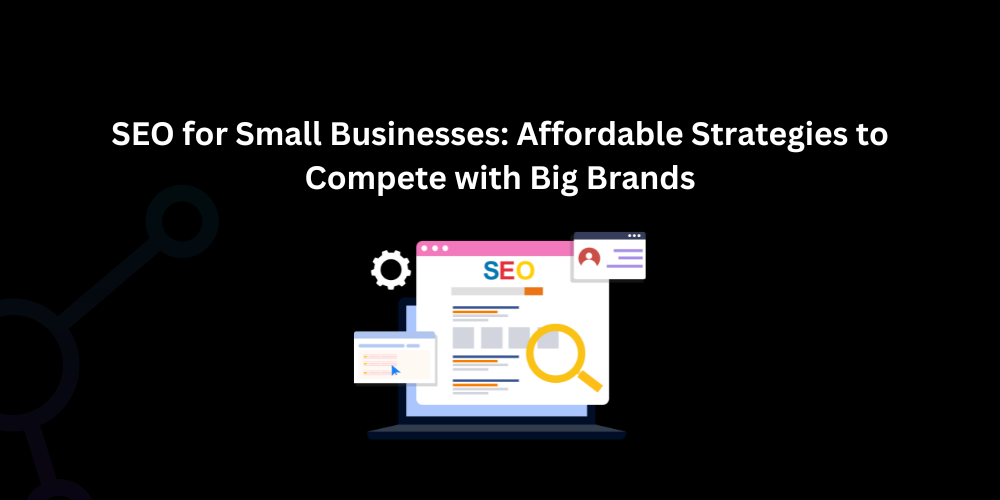
In today’s competitive online landscape, small businesses can feel overshadowed by big brands with large marketing budgets. However, with the right SEO strategies, even small businesses can improve their online visibility, reach more customers, and compete effectively. Here are some affordable, high-impact SEO tactics to help your business stand out without breaking the bank.
1. Optimize for Local SEO
For small businesses, local SEO is a powerful tool. By optimizing for local search, you can connect with potential customers in your area who are searching for services you offer. Here’s how to get started:- Claim and Optimize Your Google My Business Profile: Ensure that your business name, address, phone number, and website (NAPW) are accurate and up to date. Add photos, respond to reviews, and post regular updates to engage local customers.
- Use Local Keywords: Include location-based keywords in your website content, such as “coffee shop in [city name]” or “plumber near [location].” This helps Google know your business serves a specific area.
- Encourage Customer Reviews: Positive reviews build trust and improve your ranking on Google. Ask satisfied customers to leave reviews and respond to all feedback.
2. Focus on Long-Tail Keywords
Long-tail keywords are longer, more specific search phrases. They often have lower search volume but higher conversion rates because they capture searchers with specific intent. For example, “affordable personal trainer for beginners” is a long-tail keyword that’s easier to rank for than just “personal trainer.”- Research Long-Tail Keywords: Use free tools like Google Keyword Planner or Answer the Public to find relevant long-tail keywords.
- Integrate Keywords Naturally: Use these keywords in blog posts, product descriptions, and website content. Aim for a natural, helpful tone that answers users’ questions.
3. Create High-Quality Content That Provides Value
Content marketing is an affordable and effective way to boost SEO. By creating valuable, informative content, you can attract visitors, earn backlinks, and build authority in your industry.- Start a Blog: Write about topics that address common questions or challenges in your industry. For example, a local bakery could blog about “Tips for Baking the Perfect Bread” or “The Best Ingredients for a Gluten-Free Cake.”
- Repurpose Content: Turn blog posts into social media posts, infographics, or email newsletters. This maximizes the reach of your content without creating new material every time.
- Be Consistent: Consistency is key for SEO. Aim to publish content regularly, whether it’s once a week or once a month.
4. Optimize On-Page SEO
On-page SEO involves optimizing individual pages to help search engines understand and rank them better. Key elements include title tags, meta descriptions, headers, and image alt text.- Title Tags and Meta Descriptions: Include keywords in your title tags and meta descriptions to tell search engines what each page is about. Keep them concise and compelling to encourage clicks.
- Headers (H1, H2, H3): Use headers to structure your content, making it easier for both readers and search engines to navigate.
- Alt Text for Images: Add descriptive alt text to all images. This not only helps with SEO but also improves accessibility for users with screen readers.
5. Use Social Media to Drive Traffic
Social media can be a cost-effective way to promote your website content, engage with customers, and drive traffic to your site. While social media signals don’t directly affect SEO rankings, increased traffic and engagement can indirectly improve visibility.- Share Your Content Regularly: Promote your blog posts, product launches, and updates across platforms like Facebook, Instagram, LinkedIn, and Twitter.
- Engage with Your Audience: Respond to comments and messages, share user-generated content, and interact with local influencers to grow your social presence.
6. Build Backlinks Through Partnerships and Directories
Backlinks from reputable sites boost your site’s authority in search engines. While big brands may buy backlinks, small businesses can use free or affordable options to achieve similar results.- List Your Business on Online Directories: Submit your site to local and industry-specific directories like Yelp, Yellow Pages, or local chambers of commerce. This increases visibility and builds backlinks.
- Collaborate with Other Businesses: Partner with other small businesses to write guest posts or do joint promotions. For example, a gym could collaborate with a local nutritionist for a blog post.
7. Monitor Performance with Free Tools
Keeping track of your SEO performance is essential for continuous improvement. Thankfully, there are several free tools to help you measure what’s working and what isn’t.- Google Analytics: Track your site’s traffic, user behavior, and conversion rates to understand what drives engagement.
- Google Search Console: Monitor search rankings, identify issues, and see which keywords are bringing traffic to your site.





